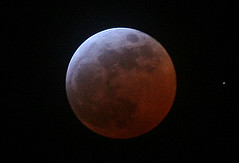Wow — what a month for celestial events! Crammed within the space of just three weeks, sky watchers will be treated to a total eclipse of the Moon (for those on the West Coast), the annual Geminid Meteor Shower, and brilliant Venus posing as our Christmas Star. And all of these sights require nothing more than the naked-eye and a clear night.
On December 10th another total lunar eclipse occurs — just as it did nearly exactly a year ago on December 21st. That one was widely viewed all over North America (see last December’s Sky Talk) but this one favors only those living along the West Coast. The partial phases of the eclipse begin at 4:46 a.m. PST and totality at 6:06 a.m., lasting 51 minutes into morning twilight. Observers in the western half of the country will be able to see at least some of the partial phases, in some places with the Moon setting as totality begins. Those in northern California, Oregon and Washington will see all of totality, while those in Alaska and Hawaii will be able to view the entire eclipse.
Next up is the annual Geminid Meteor Shower, which peaks on the night of December 13-14. Unfortunately, a bright first-quarter Moon will be lighting up the sky much of the night, cutting down on the number of meteors seen before it sets towards dawn. As one of the year’s richest displays, the Geminids should still be well worth watching despite the moonlight, with as many as 100 “shooting stars” per hour typically being seen during its peak activity under a dark sky. They appear to radiate from near Castor, one of the two bright “Twin Stars” (the other being Pollux) marking Gemini.
To find them, set your Scientifics Star and Planet Locator for about 8:00 p.m. and face northeast, where you’ll see the pair just clearing the horizon. If you watch thorough the evening hours, you’ll notice that the number of meteors seen increases as the night grows later and Gemini continues to rise ever-higher in the sky. But there’s also another less obvious factor at work here. In the evening, we’re on the side of our planet “facing away” from the direction the meteors are approaching and so they have to “catch up” with us. But after midnight we’re turned into the direction of the radiant, causing them to slam into the atmosphere at much higher speeds and resulting in many more of them being seen right up until morning twilight interferes.
Finally, Venus graces the southwestern sky at dusk this month. Often called the “Evening Star” when seen after sunset and the “Morning Star” before dawn, it’s actually, of course, a planet. But it sure looks like a “star” — in fact, the brightest one in the entire heavens! (It’s actually the third brightest object in the sky after the Sun and Moon). About an hour after sunset on Christmas Eve, it will hang some 15 degrees (or 30 full-Moon diameters) above the horizon for all to see. To many, including myself, it will indeed be our Christmas Star!
—James Mullaney
Former assistant editor at Sky & Telescope magazine and author of eight books on stargazing.


